Pingyao Ancient City A Wonderful Place to Visit
Pingyao Ancient City Overview
Pingyao Ancient City is located on Kangning Road, Pingyao County, Jinzhong City, Shanxi Province, in central Shanxi. It was originally built during the reign of King Xuan of the Western Zhou Dynasty (827 BCE–782 BCE) and was reconstructed and expanded during the third year of the Hongwu reign of the Ming Dynasty (1370). Today, it stands as the most well-preserved ancient county seat in China. The entire city resembles a tortoise crawling southward, earning it the nickname “Tortoise City.”
The ancient city comprises a vast architectural complex that includes city walls, shops, streets, temples, and residences. The layout is symmetrical, with the Market Tower as the central axis and South Street as the main axis, forming a feudal ceremonial pattern with the City God Temple on the left and the government office on the right, the Confucian Temple on the left and the Martial Temple on the right, as well as Daoist temples to the east and Buddhist temples to the west.
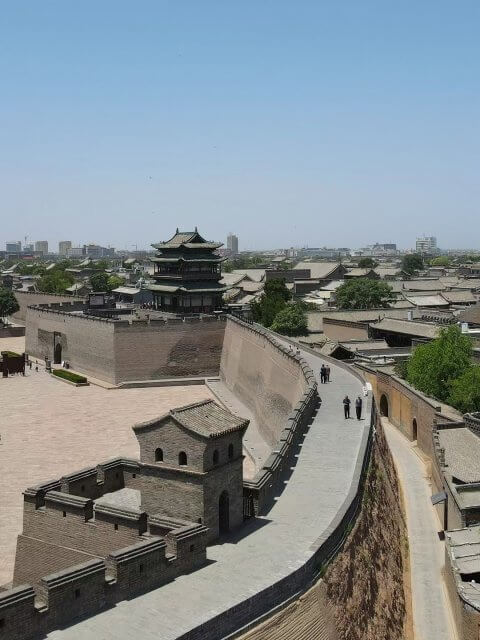
*Pingyao Ancient City City Tower.
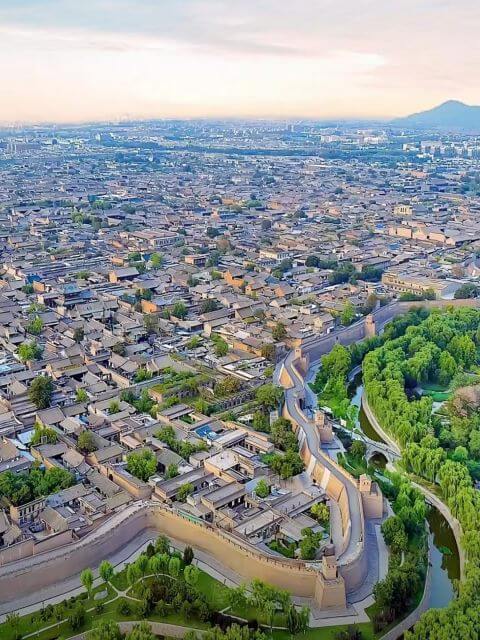
*Panoramic View of Pingyao Ancient City.
The total area covers 2.25 square kilometers. The street pattern within the city resembles the Chinese character for “earth” (土) and follows the principles of the Bagua (Eight Trigrams). The network is composed of four main streets, eight smaller alleys, and seventy-two winding lanes that create a Bagua-like diagram. The main commercial streets, including South Street, East Street, West Street, Yamen Street, and City God Temple Street, form a grid pattern.
Pingyao Ancient City is an outstanding example of a Han Chinese city during the Ming and Qing Dynasties. It has preserved all its features and presents a complete picture of cultural, economic, social, and religious development throughout China’s history. The streets and shops within the ancient city retain their historical appearance, with a design layout reflecting the urban planning concepts and structural distribution of the Ming and Qing periods.
The city showcases the evolution of Chinese architectural styles and urban planning over the past five centuries, making it a living model for studying ancient Chinese cities. It holds rich and unique value in architecture, religion, commerce, folklore, and folk art.
Architectural Layout⛩️
Pingyao Ancient City features a grand architectural complex composed of city walls, shops, streets, temples, and residential houses. The entire city is laid out symmetrically, with the Market Tower as the central axis and South Street as the main line. This forms a feudal ceremonial layout with the City God Temple on the left and the government office on the right, the Confucian Temple on the left and the Martial Temple on the right, and Daoist temples to the east and Buddhist temples to the west.
The city covers a total area of 2.25 square kilometers. The street pattern is in the shape of the Chinese character for “earth” (土) and follows the Bagua orientation, composed of four main streets, eight smaller alleys, and seventy-two winding lanes that form a Bagua diagram. The commercial streets are laid out in a grid, and the shops are solidly built with colorful paintings under the eaves and intricately carved beams. Behind the shops are traditional quadrangle courtyards made of blue bricks and gray tiles.
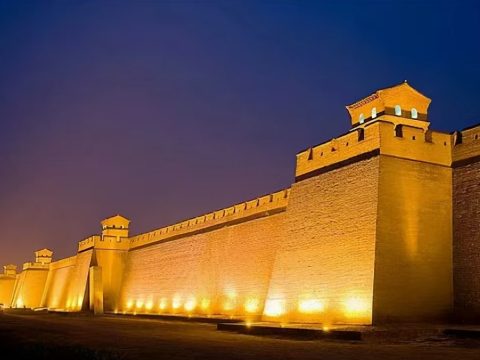
*Night View of the City Wall of Pingyao Ancient City.
Architectural Features
Residential Construction🍀
The key residential buildings within Pingyao Ancient City were mostly built during the mid to late Qing Dynasty. These structures are meticulously laid out with a clear axis, symmetrical on both sides, with a distinct hierarchy and fluctuating contours. The exteriors are enclosed, and the courtyards are deep.
The houses feature exquisite wood carvings, brick carvings, and stone carvings, complemented by paper-cut window decorations that reflect a strong local flavor. These are among the most complete and well-preserved clusters of ancient residential buildings in the Han Chinese regions.
City Building Philosophy⛷️
Pingyao Ancient City was reconstructed at the beginning of the Ming Dynasty, during a nationwide wave of city building. The expansion was based on the old Northern Wei Dynasty city with a circumference of “nine li and eighteen steps.” After the reconstruction, the city’s design more strongly reflected the traditional Han Chinese feudal order in urban planning. The city was extended westward and northward while maintaining a square shape.
Each side of the city wall was lengthened to three li, adhering to the ancient standards of “nine li for an imperial city, seven li for a dukedom, five li for a marquisate, and three li for a viscount.” Only the southern wall was adapted to follow the meandering path of the old river outside the city.
Both the internal and external layouts of the city strictly adhered to a hierarchical order emphasizing a central axis, a left side for the ancestral temple, a right side for the social temple, a balance between civil and military structures, and an orderly hierarchy. The selection, placement, size, and style of the buildings sought harmony between humans and nature, reflecting the philosophy of “unity between heaven and humanity.”
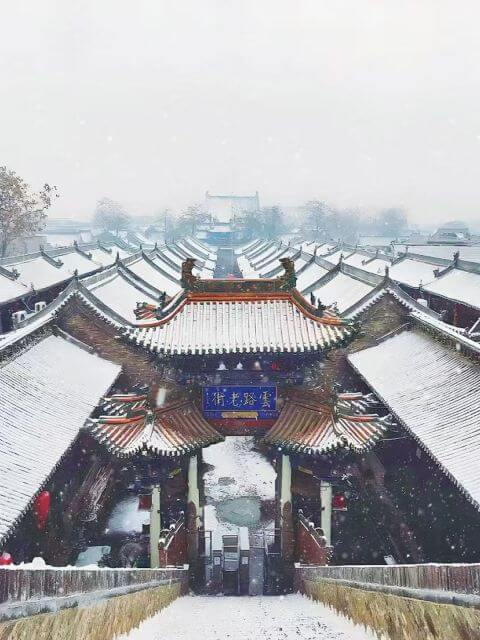
*Snow Scene of Pingyao Ancient Town.
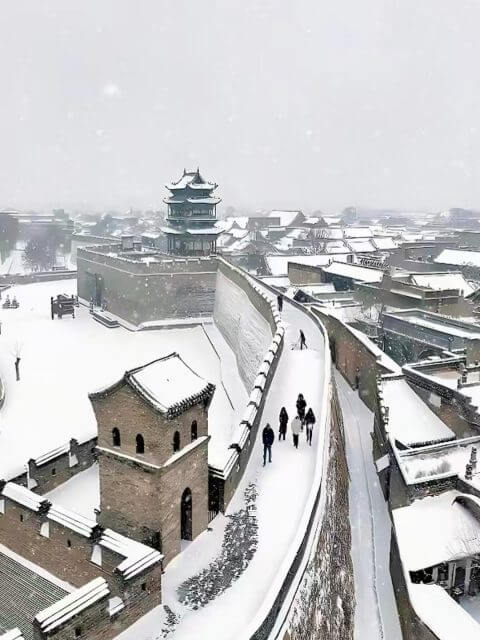
*Snow Scene of the City Wall in Pingyao Ancient Town.
Major Structures
Cultural Relics🪨
Pingyao Ancient City is rich in cultural relics. There are nine national-level protected heritage sites, 1,075 immovable cultural relics, and 199 streets and alleys within the city. More than 220 ancient shops line the major streets, and the city boasts 3,798 ancient residential buildings with preservation value, 448 of which are completely intact. Both within and outside the city are over 300 sites of various relics and ancient buildings, as well as more than 1,000 stone inscriptions and numerous colorful glazed artifacts from different eras.
Pingyao City Wall🧱
The Pingyao City Wall was originally built during the reign of King Xuan of the Western Zhou Dynasty and was reconstructed in 1370 during the Ming Dynasty. It was subsequently renovated and expanded over the centuries to its current scale. The wall is square-shaped, with a total length of 6,142.63 meters. It consists of the main wall, horse-face battlements, parapets, and crenellations, with six barbicans and six gates: one each in the north and south, and two each in the east and west.
The south gate is called Yingxun Gate, and the north gate is Gongji Gate, while the upper east gate is Taihe Gate, the lower east gate is Qinhang Gate, the upper west gate is Yongding Gate, and the lower west gate is Fengyi Gate. Each barbican features a double-eaved hip-and-gable-roof tower. Originally, there were drawbridges outside the barbicans. The southeast corner of the wall has Wenchang Pavilion and Kuixing Tower.
The wall is on average 10 meters high, with a base width of 8–12 meters and a top width of 2.5–6 meters. The exterior is made entirely of blue bricks, with the interior being rammed earth, and the top paved for drainage. Along the wall, there are 94 watchtowers, including corner towers, spaced about 50 meters apart. The outer side of the wall has a 2-meter-high parapet, while the inner side has a low crenellated wall.
Additionally, there are 72 enemy towers spaced 40–100 meters apart, with 3,000 crenellations. Outside the city, the moat is 4 meters deep and wide, lined with locust and willow trees.
Pingyao Confucian Temple🛕
The Pingyao Confucian Temple, located in the southeastern corner of the city on Wenmiao Street, was built during the early Tang Dynasty. It is south-facing and adjacent to the City God Temple Street. The temple complex includes the central Confucian Temple, with the East School to the left and the West School to the right.
Along the central axis are the Lingxing Gate, Dacheng Gate, Dacheng Hall, Minglun Hall, Jingyi Pavilion, and Zunjing Pavilion, forming six courtyards. The temple occupies a total area of 35,811 square meters, with the temple area itself covering 8,649.6 square meters. Flanking the temple’s entrance are two stone archways.
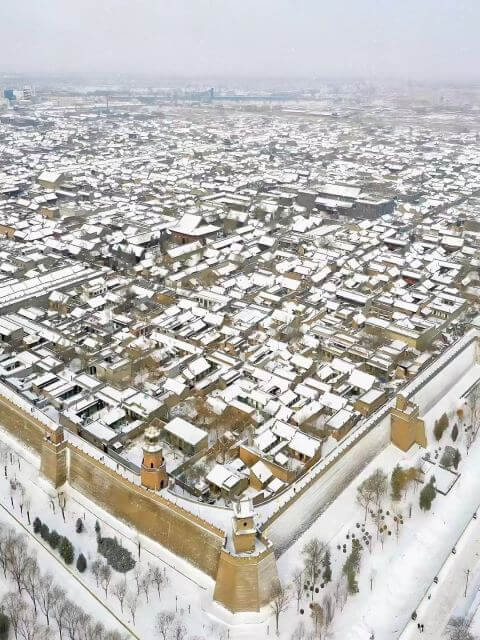
*Snow Scene of the Entire Pingyao Ancient City.
Pingyao Market Tower
Located on South Street in Pingyao Ancient City, the Market Tower connects the north and south ends of South Street. Although the exact date of its original construction is unknown, it was rebuilt in the 27th year of the Kangxi reign (1688) of the Qing Dynasty and underwent repairs during the reigns of Qianlong, Jiaqing, Daoguang, Tongzhi, Guangxu, and Xuantong. The southeast corner of the tower has a well with water said to be as golden as the color, giving the tower the alternate name “Golden Well Tower.” In the Qing Dynasty, the tower was listed as one of Pingyao’s “Twelve Scenic Spots.”
Qingxu Temple🏮
Qingxu Temple, situated on the north side of East Street, was originally built during the Tang Dynasty and was known as Taiping Temple. It was renamed Qingxu Temple during the Northern Song Dynasty and later became Taiping Xingguo Temple before reverting to Qingxu Temple in the Qing Dynasty.
The temple complex covers 5,890.9 square meters, with a building area of 2,210.2 square meters. It has three courtyards arranged along a central axis, featuring structures like the archway, mountain gate, Longhu Hall, Pure Yang Hall, Three Purities Hall, and Jade Emperor Pavilion. The temple houses eight clay sculptures from the Yuan Dynasty and over fifty steles dating from the Song, Yuan, Ming, and Qing dynasties.
City God Temple
The City God Temple is located on the north side of City God Temple Street, built facing south. It was renovated during the 33rd year of the Jiajing reign (1554) in the Ming Dynasty and later repaired during the Tongzhi reign of the Qing Dynasty. Covering 6,090 square meters, it features three entrances. The complex includes a mountain gate, bell and drum towers, stage, chancel, main hall, and east and west wing halls. There is a spring inside the temple that never runs dry, where visitors can still fetch water today.
Huiji Bridge🌉
Huiji Bridge is located 300 meters northeast of the Lower East Gate of Pingyao Ancient City, spanning the downstream section of the Huiji River. It is a multi-arched stone bridge, commonly known as the “Nine-Eyed Bridge.” According to inscriptions, it was originally a wooden bridge and was first replaced with a five-arched stone bridge in the 10th year of the Kangxi reign (1671) of the Qing Dynasty.
In the 36th year of Kangxi’s reign (1697), it was expanded to a nine-arched bridge. The bridge underwent repairs and reconstructions during the Qianlong, Tongzhi, and Guangxu reigns. In the late Qing Dynasty, Huiji Bridge was recognized as one of Pingyao’s “Twelve Scenic Spots” under the name “Wild View from the Riverside Bridge.”
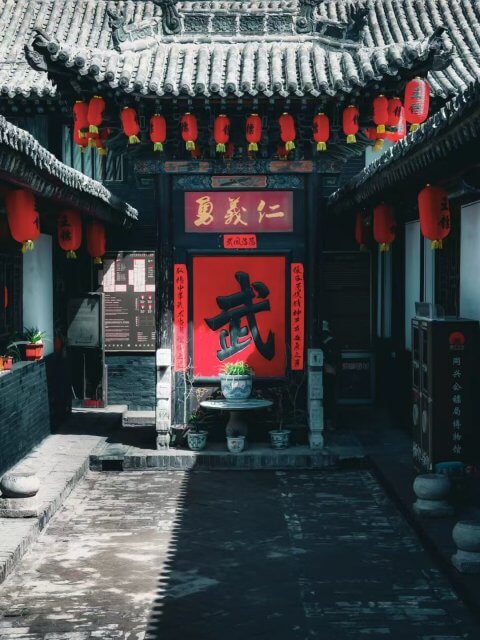
*Ren Yong Yi of Pingyao Ancient Town.
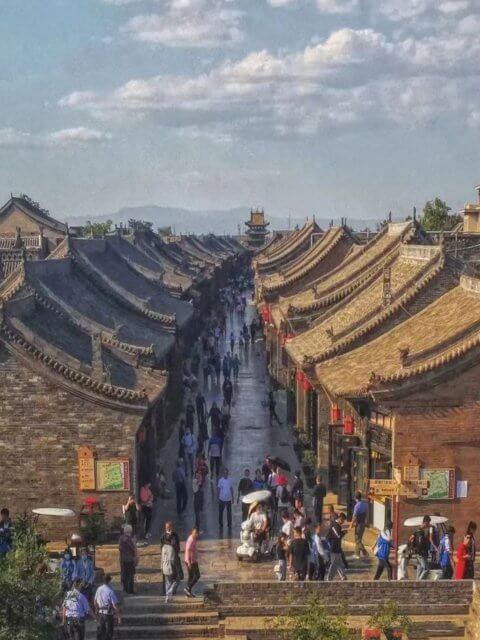
*A Scene of the Streets in Pingyao Ancient City.
Zhenguo Temple🏇🏻
Zhenguo Temple is situated 15 kilometers east of Pingyao Ancient City in Haodong Village, Xiangyuan Township. Originally named Jingcheng Temple, it was founded in the 7th year of the Tianhui era (963) during the Northern Han period of the Five Dynasties. It was renamed Zhenguo Temple in the 19th year of the Jiajing reign (1540) of the Ming Dynasty. The current structures within the temple mostly reflect Ming and Qing architectural styles, though the Hall of Ten Thousand Buddhas and the clay sculptures within still retain their original Five Dynasties appearance.
The temple is oriented north-south, consisting of two courtyards, and covers an area of 4,500 square meters. The Hall of Ten Thousand Buddhas sits centrally, with the Heavenly Kings Hall, Bell and Drum Towers, and a stele corridor in the front courtyard. The rear courtyard features the Three-Buddha Pavilion, flanked by the Guanyin Hall and the Ksitigarbha Hall. The Hall of Ten Thousand Buddhas is nearly square in plan, with three bays in both width and depth.
Unlike many traditional halls, it has no moon platform at the front, and its base is relatively low. Doors are set at the central bays of both the front and rear eaves, while windows are placed at the side bays of the front eave; the rest are solid walls. The eave columns, twelve in total, are embedded in the walls. The column capitals are smoothly curved with minimal rise, and the beams connect seamlessly without protruding ends, omitting decorative brackets.
Shuanglin Temple🪭
Shuanglin Temple is located 6 kilometers southwest of Pingyao Ancient City, north of Qiaotou Village in Zhongdu Township. The temple’s exact founding date is unknown, but it was originally named Zhongdu Temple. According to an existing stele from the 4th year of the Dazhong Xiangfu era (1011) of the Northern Song Dynasty, Zhongdu Temple was initially built in the 2nd year of the Wuping era (571) during the Northern Qi Dynasty.
It was later destroyed by war, then rebuilt during the Song Dynasty, at which time it was renamed Shuanglin Temple, inspired by the Buddhist scripture reference to “Buddha’s nirvana under the twin Sala trees.” Subsequent reconstructions took place during the Jingtai, Tianshun, Hongzhi, Zhengde, Jiajing, and Wanli reigns of the Ming Dynasty, with additional repairs during the Daoguang and Xuantong reigns of the Qing Dynasty. The existing structures are mostly remnants of Ming Dynasty architecture.
Main Attractions
Tianjixiang Museum🥌
Located at No. 20, East Road, North Entrance of South Street, Pingyao Ancient City, the Tianjixiang Museum is the former site of Changshengwei, the only multinational trading firm within the ancient city. Established in 1896 during the Guangxu period of the Qing Dynasty, Changshengwei ceased operations in 1917 after 21 years of business. It underwent two name changes, originally operating under the names Changshengyu and Changshengqing General Store.
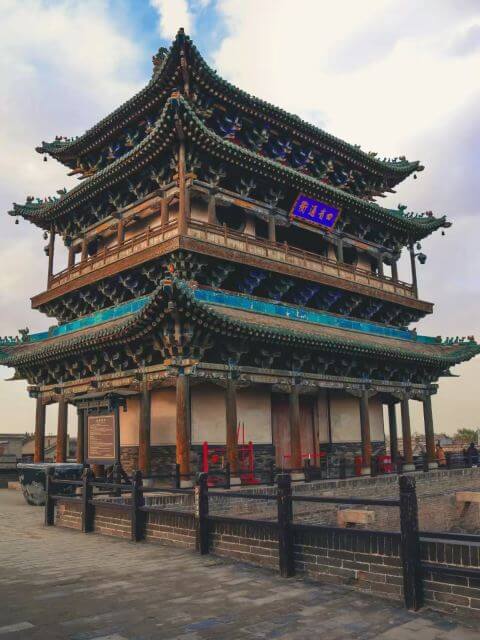
*Stilted Houses in Pingyao Ancient City.
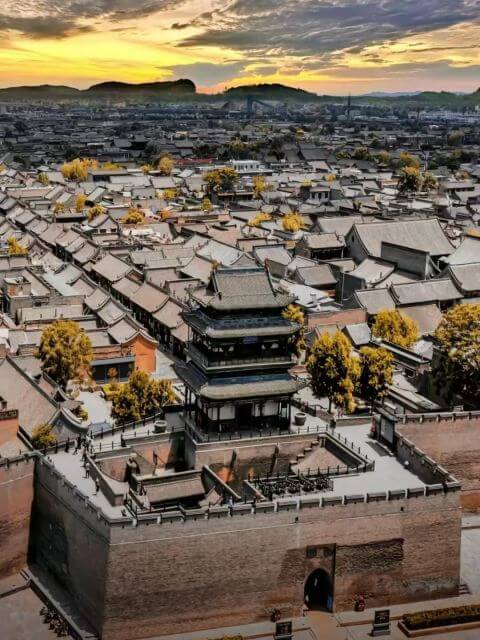
*Overall View of Pingyao Ancient City.
Ancient Residential Complex Exhibition Hall
The Pingyao Ancient Residential Complex Exhibition Hall, located at No. 18 West Street in the ancient city, was built during the Kangxi period of the Qing Dynasty. It is the former site of the “Weifenghou” draft bank, consisting of a grand mansion with a frontage of five bays, connecting two sets of courtyards from north to south, covering a total area of over 1,460 square meters.
The northern courtyard, facing south, has its main entrance on the street and represents a typical commercial three-entry courtyard structure. The southern courtyard, facing north, has a more hidden entrance and is a standard residential four-entry courtyard with a main courtyard and two side courtyards, linked by a narrow passageway. Known for its distinctive layout and elegant construction, the residence showcases the unique features of Pingyao’s courtyard architecture, earning the nickname “Yuanbao Courtyard.”
China Chamber of Commerce Museum🎨
The China Chamber of Commerce Museum was established in September 2002 at the former site of the Pingyao Chamber of Commerce. The museum’s name was inscribed by Jing Shuping, former Vice Chairman of the National Committee of the Chinese People’s Political Consultative Conference and former Chairman of the All-China Federation of Industry and Commerce.
The museum’s rich collection vividly brings to life the history of the Pingyao Chamber of Commerce and its critical role in modernizing China’s economy, democratizing politics, and promoting national independence.

694x469-300x203.png)